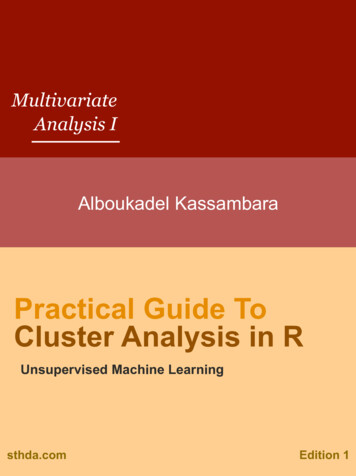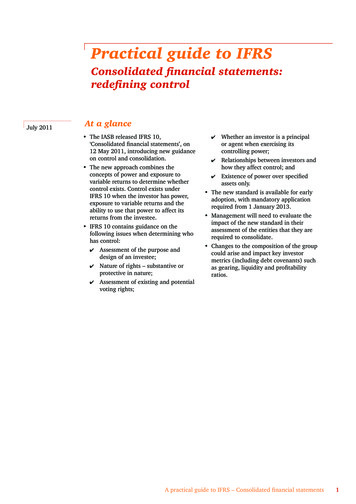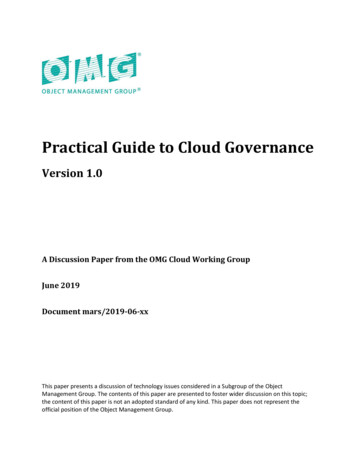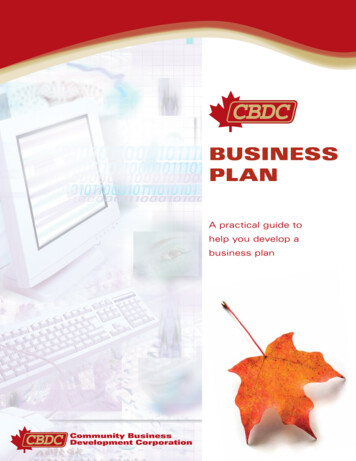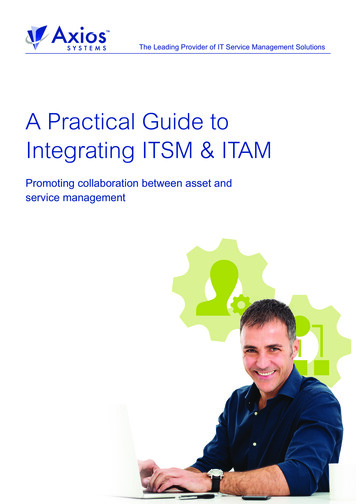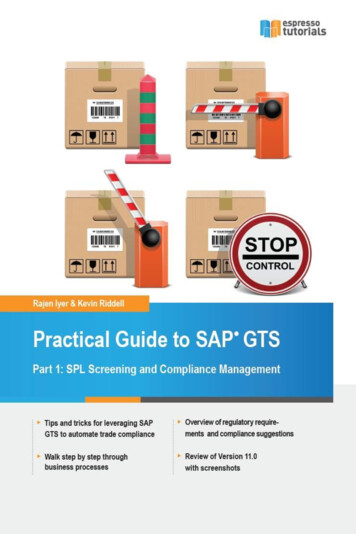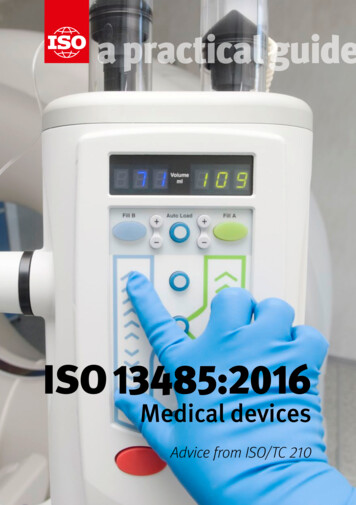
Transcription
a practical guideISO 13485:2016Medical devicesAdvice from ISO/TC 210
a practical guideISO 13485:2016Medical devicesAdvice from ISO/TC 210
Copyright protected documentAll rights reserved. Unless otherwise specified, no part of this publication may be reproduced or utilizedotherwise in any form or by any means, electronic or mechanical, including photocopying, or posting onthe internet or an intranet, without prior written permission. Permission can be requested from eitherISO at the address below or ISO’s member body in the country of the requester. ISO 2017. Published in SwitzerlandISBN 978-92-67-10774-5ISO copyright officeCP 401 CH -1214 Vernier, GenevaTel. 41 22 749 01 11Fax. 41 22 749 09 47E-mail copyright@iso.orgWeb www.iso.org2 ISO 13485:2016 — Medical devices — A practical guide
About this handbookAll organizations face challenges when developing or updating their quality management system (QMS) and it is hoped that this handbook will beused to provide additional insight and understanding of the requirements inISO 13485 1), Medical devices — Quality management systems — Requirementsfor regulatory purposes. It is not expected that you will sit down and readthis handbook in one sitting, but that you might use it as a reference whenquestions come up about specific requirements. Therefore, it is broken upinto the sections outlined in the contents in line with the clause structure ofISO 13485. It is expected that you have basic practical experience with QMSand the applicable regulatory requirements within the medical devices sectorto effectively understand the guidance provided. In this handbook, advice toguide understanding of ISO 13485 and its application is given by first listingthe full text of ISO 13485, followed by the intent of that section and relevantguidance. Examples have been used wherever possible as an aid to understanding what the requirements mean.This handbook has been written by a task group of technical experts from ISO’sTechnical Committee TC 210. A draft was circulated to all the member nationalstandards bodies and liaison organizations of ISO/TC 210 to obtain feedbackand comments; these have been considered by the task group prior to releaseof the final text. The requirements of ISO 13485 are general in nature and,with the exception of a few subclauses that are applicable to specific medicaldevice types, are intended to be applicable to all medical device organizations,regardless of their type, size, or the product they provide. This handbook isintended to guide organizations that provide product, including services,that affect any part of the lifecycle or supply chain of a medical device. Suchorganizations can be manufacturers, importers, distributors, service providers or authorized representatives. In addition, this handbook can be usefulto regulatory authorities and certification bodies concerned with conformityto ISO 13485.1) In this handbook, the reference to ISO 13485 pertains to the third edition published in2016 unless a different date is included in the reference.ISO 13485:2016 — Medical devices — A practical guide 3
The guidance given in this handbook describes concepts and methods that canbe considered by your organization to assist in the development, implementation and maintenance of your QMS and this can be applicable to the design,development, production, installation, servicing and post market surveillanceof medical devices. This handbook has taken into consideration requirementsand guidance contained in documents as listed in the bibliography from thefollowing organizations: International Medical Device Regulators Forum (IMDRF) including thosedocuments maintained from the disbanded Global Harmonization TaskForce (GHTF); International Organization for Standardization (ISO); European Committees for Standardization (CEN and CENELEC); National regulatory bodies.This handbook does not define any requirements nor add to or otherwisechange the requirements of ISO 13485 and is intended to assist interested parties with the application of ISO 13485. The guidance contained in this handbook is intended for educational purposes and is not intended to be used toassess or audit compliance with regulatory requirements or to be used foridentifying specific deficiencies of a QMS, unless the guidance is voluntarilyincorporated into the documentation describing and supporting your organization’s QMS, or unless such guidance is specifically made part of the regulatory requirements relevant to your organization’s operation. It should benoted that this handbook does not set out to provide specific guidance withrespect to generic QMS requirements which are common to both ISO 13485 andISO 9001.4 ISO 13485:2016 — Medical devices — A practical guide
Contents PageForeword. 6Introduction. 101Scope. 232Normative references. 273Terms and definitions. 294Quality management system. 315Management responsibility. 596Resource management. 797Product realization. 938Measurement, analysis and improvement. 165Annex A — Guidance for small organizations. 209Bibliography. 215ISO 13485:2016 — Medical devices — A practical guide 5
ForewordQuality Management Systems (QMS) — General commentsA QMS is the way your organization directs and controls those activities that arerelated, either directly or indirectly, to achieving its intended results. Broadly, itconsists of your organization’s structure together with the planning, processes,resources and documents or records that you use to achieve your quality objectives (such as meeting your customers’ and applicable regulatory requirements,establishing and maintaining your QMS, or improving your product).Generic QMS requirements are defined in ISO 9001 and are intended to beapplicable to any organization, regardless of its type or size, or the product itprovides. However, the requirements of ISO 13485 are intended to be applicableto any medical device organization regardless of size and activity as a basis fordemonstrating and supporting compliance with applicable regulatory requirements. User should also be aware that ISO 13485 is based on the format of itsprevious edition (ISO 13485:2003) and ISO 9001:2008 and not the High LevelStructure for Management System Standards as defined in ISO/IEC Directive,Part 1, Annex SL used for ISO 9001:2015. Annex B of ISO 13485 contains a tablecross-referencing the clauses of ISO 13485 and ISO 9001:2015.Further reference can be sought from ISO 9000:2015 Quality management systems — Fundamentals and vocabulary, including the fundamental concepts,the quality management principles, as well as the terms and definitions forquality management. Any differences in definitions of terms between ISO 9000and ISO 13485 are contained in Clause 3 of ISO 13485.When putting a QMS in place, a good understanding of the detailed requirements for a QMS is necessary. There are several sources for information thatyou can use (see the bibliography), in addition to this handbook. The standards and other references provided in this handbook could be used by yourorganization to meet the applicable regulatory requirements, but that is adecision your organization should make and this handbook does not outlineany requirements to adopt conformity to any standard.One fundamental concept that your organization has to understand is theconcept of quality. From ISO 9000:2015, the quality of product includes not6 ISO 13485:2016 — Medical devices — A practical guide
only their intended function as well as safety and performance, but also theirperceived value and benefit to the customer. From the perspective of the medical device industry, this includes the therapeutic benefit to a patient.In general, QMS standards should not be confused with product standards.While product standards give explicit requirements for a particular product,including service, QMS standards specify requirements for good managementpractices in order to have a high probability to achieve quality, but generallywithout referencing any particular type of product. ISO 13485 does providerequirements for identified types of product (e.g., requirements for sterile medical devices, implantable medical devices).The use of product standards, QMS standards and quality improvementapproaches are all means of improving your organization’s ability to meetcustomer and applicable regulatory requirements or the competitiveness ofyour organization (recognizing that these are not exclusive of each other).Implementation of a QMS should not result in excessive bureaucracy, paperwork, or lack of flexibility. Nor should your QMS be an unreasonable financialburden. Expenditures relating to implementing and maintaining a QMS shouldbe considered an investment with a return on investment in the form of benefits and improvements. Every organization will already have a managementstructure and this should be the basis on which its QMS is built.What is an ISO 13485 Quality Management System?A QMS conforming with ISO 13485 requirements is a documented set of interrelated processes, including any forms or templates, that establish, implement,and maintain the provisions outlined in the requirements of the standardwith the aim of meeting customer and applicable regulatory requirements forbusinesses operating in the medical device sector. These processes and theirinteractions are also subject to improvement as directed by top managementto achieve quality objectives. The intent of the latest edition of ISO 13485 isnot to impose new requirements on your organization, but to clarify existing requirements that were vague, confusing or implicit in nature to ensurecommon interpretation by all users. If your QMS already exists and is basedon one of the older editions, it will need to be updated to ISO 13485. WhetherISO 13485:2016 — Medical devices — A practical guide 7
you are implementing a new QMS or updating your existing QMS, the advicegiven in this handbook is relevant.ISO 13485, Annex A provides some detailed commentary on the changesbetween the 2003 and 2016 editions. This annex is recommended readingprior to planning for transition as it will assist in the development of transition plans. However, the whole content of the respective clauses should beconsidered when determining what action is required and not just the topicslisted in Annex A in order to ensure full compliance with the requirements.Furthermore, ISO 13485, Annex B provides a correlation between ISO 13485 andISO 9001:2015. This will be of particular use and benefit to your organizationif it currently holds dual certification to both ISO 9001 and ISO 13485 and youwish to continue to hold dual certification. See the guidance on Clause 0.4 foradditional information.Why have a quality management system (QMS)?The adoption of a QMS is a strategic decision that guides your organization toimprove its overall performance and to provide a sound basis for its sustainable development initiatives. Clause 0.1 of ISO 13485 lists several reasons forhaving a QMS.Many organizations implement a formal QMS after finding that their customersin both the private and public sectors want assurance that the product theyintend to purchase will meet their requirements for quality. Those customersare looking for the confidence that can be provided by an organization offeringproduct produced under a suitable, adequate and effective QMS, such as oneconforming to ISO 13485.For medical device organizations, compliance with ISO 13485 can support conformity assessment options that are used in different regulatory jurisdictions.A QMS on its own will not necessarily lead to an improvement of work processesor to improvements of your product. It won’t solve all your problems. It is ameans for you to take a systematic approach to fulfilling your organization’sobjectives, which in turn should achieve such improvements.8 ISO 13485:2016 — Medical devices — A practical guide
ISO 13485 contains requirements for improvement, using feedback fromsources such as complaint handling, post market surveillance, handling ofnonconformities, corrective actions and preventive actions. You use theseprocesses to ensure that worthwhile and cost effective improvements are beingachieved.ISO 13485:2016 — Medical devices — A practical guide 9
to ISO 13485. 1) In this handbook, the reference to ISO 13485 pertains to the third edition published in 2016 unless a different date is included in the reference. ISO 13485:2016 — Medical devices — A practical guide 3. The guidance given in this




